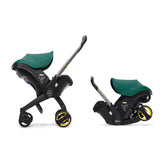How to Survive the Terrible 3s with Your Sanity Intact

When a little one finally figures out they can exert some control over what goes on around them… look out world! Between the ages of two and four, many children become more demanding and defiant. This often results in temper tantrums and other challenging behaviors, thus giving rise to the phrase the “terrible 3s.” It’s a normal part of development that typically subsides as children mature and gain greater emotional control. However, it can be an extremely frustrating time for parents. If you’re wondering how to deal with 3-year-old tantrums or how to deal with behavior problems in 3-year-olds, you’re not alone. Keep in mind that every child is different. What helps calm one child may not help another, and that’s alright. Let’s take a look at a few strategies for how to deal with tantrums in 3-year-olds and ways you may be able to adapt these ideas to your own individual child and family.
Why Do Kids Have Temper Tantrums?
Temper tantrums vary in intensity, from crying and whining to yelling, slapping, and breath-holding spells. Both boys and girls exhibit tantrums equally between the ages of one to three years. Some children have them frequently, while others almost never have them. At its core, a tantrum is a child’s way of expressing frustration, disappointment, or discomfort.
Lots of factors can trigger a tantrum in young children. Fatigue, hunger, unexpected transitions, or not getting something they want (like attention or a toy) can all instigate a meltdown. Learning to manage frustration and control their emotional response is a developmental skill that children learn over time.
In addition, young children often don’t yet have the verbal skills to express what they want or need. The language that describes feelings is more complex and tends to develop later. Thus, a child’s frustration may trigger a tantrum. As they mature and get a better grasp of their vocabulary, tantrums tend to decrease.
The desire for autonomy and control over their surroundings also leads to power struggles with young children – even when it’s a situation they can’t really handle. “I can do it by myself” or “I want it right now” are common refrains for 3-year-olds. When they realize they’re not able to do it or can’t get what they want, they may have a meltdown.
Are Terrible 3s Worse than Terrible 2s?
For the most part, trying to figure out how to deal with tantrums in 3-year-olds isn’t much different than how to deal with tantrums in 2-year-olds. The biggest difference may be that the older child is more aware of their autonomy and may express themselves with more confidence and forcefulness. That said, neither will have yet developed the ability to express their emotions well. Fortunately, this “terribleness” is only a temporary phase.

How to Avoid 3-Year-Old Temper Tantrums
Though some tantrums are spontaneous and unexpected, many times caregivers can spot a child getting upset. Understanding your child’s triggers and planning ahead may help. Here are a few recommendations for minimizing temper tantrums in 3-year-olds:
- Understand your child’s limits and set reasonable expectations for behavior.
- Clearly communicate your rules and stand by them. Don’t negotiate.
- “Catch” them being good and praise their behavior.
- Encourage autonomy by letting them help with little chores around the house.
- Prepare your little one for potentially unpleasant transitions by talking about things before they happen (e.g., “We are going to leave the playground in 5 minutes.”).
- Try to maintain a regular routine for meals and bedtime.
- Think a few steps ahead. If tantrums are most extreme when your child is hungry, keep healthy snacks on you when you're out running errands. If they’re worse when your little one is tired, try to prioritize sleep time, even if you end up missing other events.
- Offer your child small, directed choices over little things when they can’t control the big things. For instance, “It’s time to go to bed. Do you want to wear the red pajamas or the blue ones?”
- Help your child recognize and label their feelings. This will help them learn how to put their emotions into words instead of acting out. For example, say, “I see that you are frustrated because the blocks keep fallings down.”

How to Respond During a Temper Tantrum
Generally, the best way to respond to a tantrum is to stay calm. If you react with loud, enraged outburts, your child may be inclined to mimic your behavior. Yelling, hitting, or spanking a child never improves the situation.
Instead, try to divert your child’s attention. Move to a different room. Offer a safer toy. Sing a silly song. If you've asked your little one to do something they don’t want to do, follow through by offering assistance. If you've asked your child not to play in a certain spot, show them a place where it is okay to play.
Tantrums may be managed differently depending on why your child is upset. For example, if a tantrum is happening because a child wants attention, you may choose to simply ignore it. If a tantrum happens after your child doesn’t get what they want, remain calm. Avoid over-explaining why they can't have what they want. Move on to a different activity instead. If a tantrum escalates, remove your child from the situation. Use a time-out to give them a chance to calm down.
If your child is hitting or kicking someone, trying to run into the street, or engaging in otherwise dangerous behavior, hold them tightly until they’re calm. Once they’ve settled down, calmly explain your rules.
When to Call the Doctor About the Terrible 3s
Temper tantrums typically occur less frequently as children get older. In between tantrums, your child should exhibit otherwise normal behavior. You may want to reach out to your pediatrician if you notice any of the following:
- Temper tantrums seem to last frequently or occur very often.
- Your has difficulty talking and can’t express what they need.
- Temper tantrums persist or seem to get worse after age four.
- Your child hurts themselves or others during tantrums.
Looking for tools to help your little one calm down? ANB Baby offers a wide range of sensory toys that many children find soothing.









